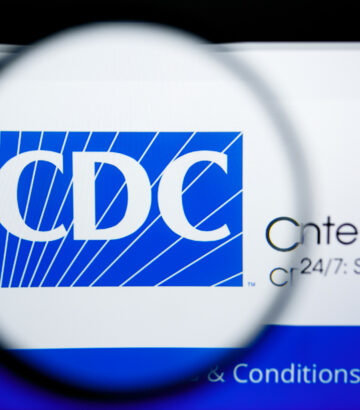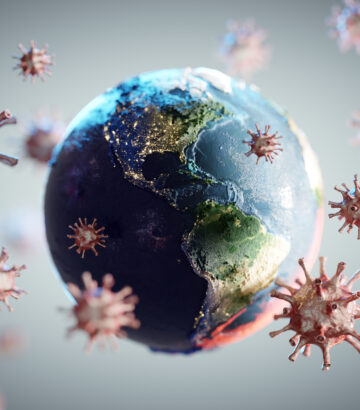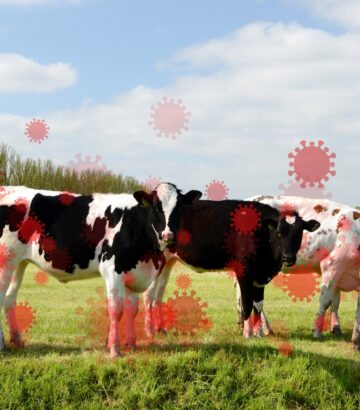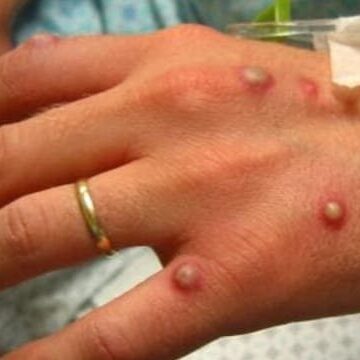Public Service Announcements
April 6, 2025
August 17, 2024
Scientists and Economists Alert!
Global Emergency
Compounded by the AIDS-like Features of SARS-CoV-2 Infection
Over a million people in the US are being infected with severe acute respiratory syndrome coronavirus type 2 (SARS-CoV-2) every day.
Originally named after the acute respiratory syndrome it can cause as a consequence of blood vessel damage in the lungs, SARS-CoV-2 is actually primarily a blood vessel virus that spreads through the airways. It causes a complex multisystem disease (1). It is airborne (2). It can persist in the body, and is detectable in body and brain tissue even at autopsy of “recovered” patients (3).
Each infection ages the body, causes damage to the blood vessels and the immune system, and affects organs including the heart, lungs, liver, kidneys, bones, etc. (4, 5, 6)
Each infection ages the brain. Specifically, it reduces gray matter and cognitive ability (7), and potentially IQ score (8). It increases the risk of psychiatric disorders (9). SARS-CoV-2 has also been identified as contributing to accelerated dementia (10).
The potential post-acute phase impacts of SARS-CoV-2 include long COVID, some manifestations of which are chronic conditions that can last a lifetime, including heart disease, diabetes, myalgic encephalomyelitis and dysautonomia (11).
The Economist has estimated excess deaths from the beginning of the Pandemic through May 2024 at up to 35 million people worldwide. (12)
In Addition, Many Scientists Are Now Issuing Warnings…
SARS-CoV-2 triggers a new airborne form of Acquired Immune Deficiency Syndrome (13, 14, 15) (some are proposing specific terms such as “CoV-AIDS”).
This is not AIDS as we know it from human immunodeficiency virus (HIV) infection, it is a new type of acquired immunodeficiency syndrome with different deleterious effects on immune function (16, 17, 18, 19, 20, 21), but both resulting in increased vulnerability to infections (22). Immune system deficiency and other COVID properties also suggest a potential link to greater risk of cancers (23, 24, 25, 26, 27).
The “original” AIDS caused by HIV takes up to around 10 to 15 years to make its presence felt, with the initial infection usually barely noticed and often resembling the common cold or a flu-like disease until its damage manifests itself leading to death in the absence of treatments (28, 29).
With SARS-CoV-2, immunodeficiency develops in the weeks and months following infection. It involves reduction and functional exhaustion of T Cells (30), enhanced inhibition of MHC-I expression (31), downregulating CD19 expression in B cells (32) and other evidence of immune dysregulation (33, 34). In one study, the dysregulation persisted for 8 months following initial mild-to-moderate SARS-CoV-2 infection, the length of the study (35). There is no “cure” for any of the damage caused by SARS-CoV-2 including immune dysregulation.
Did You Know?
- Repeated infections are leading to prolonged immune dysregulation, and increase the risk of progressive disability and death.
- Long COVID is a multisystem disease with debilitating symptoms, which has had a profound impact on society and the global economy. In the USA, economists have estimated that long COVID will incur cumulative future costs of more than US$4 trillion (36, 37).
- The worldwide devastating economic consequences of this mass disabling event have been measured in terms of total work hours and GDP lost around the world (38).
- It theoretically only takes a single viral particle to initiate an infection, and most infections are initiated by very few viral particles (39).
- Despite current popular belief, the immune system is NOT a muscle, and does NOT benefit from being repeatedly challenged with disease-causing microbes. In fact, its finite resources are depleted with each new infection.
- Herd immunity is unattainable for a rapidly mutating, immune-disrupting virus, and there is no basis to believe that a vascular infection will evolve into the common cold.
- Continuing to ignore SARS-CoV-2 will not make it go away. Depriving the virus of publicity does not deprive it of its continuing lethal effects.
- SARS-CoV-2 is continuing to evolve and mutate – it is not running out of evolutionary space. It is not a cold or the flu, but primarily a blood vessel disease. It is damaging society as we know it.
- How many repeated infections can we expect young people to endure and survive? Even if they get only 1 infection each year, that’s 10 infections in 10 school years. This is not compatible with health and a long life. Repeated infections can lead to long COVID and shortened lifespans.
How Do We Protect Ourselves, How Do We Protect Our Children, When Government Public Health Advice Has Failed?
- By reducing transmission so that R0 remains less than one (meaning that each person infects less than one other), we can suppress and gradually eliminate the virus, targeting a safer return to pre-2020 normal.
- Handwashing is helpful, but it is not the main way to stop the spread of this airborne virus.
- Respirators can block 95% or more of virus particles through electrostatic action, and are therefore highly effective at reducing infection even if only one person in a conversation is wearing them. They are far more effective if all people are wearing them (40).
- Transmission can be reduced with HEPA filtration and ventilation of indoor air.
- The virus spreads more quickly in indoor settings, but also spreads outdoors.
- For medical facilities, it is essential to clean the air with ventilation and filtration and require universal high-quality masking (with N-95/ FFP3 respirators or better) to protect medical staff and patients.
- For workplaces, clean air will reduce transmission; and encouraging employees to test and stay home when infectious is essential. High-quality masking should be encouraged in the case of symptoms, a sick person at home, or any other suspicion that one could be carrying the virus. Remote work should be normalized and encouraged wherever possible.
- For entertainment venues, events should be held outdoors when possible; and if indoors, clean air is key to protecting audiences. Audiences should also be encouraged to wear respirators to avoid getting infected and infecting others. Digital streaming options should always be offered.
- For restaurants, an emphasis on outdoor dining will substantially reduce transmission. Patio service should be encouraged, and indoor dining areas should be well-ventilated with a high level of air-exchanges. Home or curbside delivery offers a safer alternative.
- For schools, clean air will reduce transmission; encouraging students to test and stay home when infectious is essential to preserving their health. Masking or remote learning should be initiated whenever a case is detected or the incidence in the general population sharply increases. A permanent hybrid model / digital option can accommodate children with disabilities or those who simply do better learning from home.
- Teachers and medical professionals may prefer to use transparent masks, or to wear HEPA-filtered headgear equipment that may be more universally tolerated/accepted.
- To track our progress, we need sustained wastewater and population-level testing.
With just 60-70 percent of people taking mitigation measures such as masking, testing and isolating when infected, we can dramatically reduce forward transmission of the virus. Even with very imperfect measures, as long as one infected person does not infect more than one person on average, the virus will eventually die out. The fewer people each person infects on average, the faster it will happen.
We still have a window of opportunity. Protecting ourselves and our families is in fact protecting the economy and the continued orderly functioning of our society.
________________________________________________________________
References
- Roberts, C. M.; Levi, M.; McKee, M.; Schilling, R.; Lim, W. S.; Grocott, M. P. W. COVID-19: A Complex Multisystem Disorder. British Journal of Anaesthesia 2020, 125 (3), 238–242. https://doi.org/10.1016/j.bja.2020.06.013.
- Molteni, M; Covid ignited a global controversy over what is an airborne disease. The WHO just expanded its definition, Statnews April 18, 2024 https://www.statnews.com/2024/04/18/covid-airborne-transmission-disease-who-expanded-definition/
- Stein, S. R.; Ramelli, S. C.; Grazioli, A.; Chung, J.-Y. et al. SARS-CoV-2 Infection and Persistence in the Human Body and Brain at Autopsy. Nature 2022, 612 (7941), 758–763. https://doi.org/10.1038/s41586-022-05542-y.
- Joffe, D., Bilodeau, S., Šalamon, Š., Ewing, A., Bar-Yam, Y., Pretorius, R., & Fox, G.. Spectrum of COVID-19: From Asymptomatic Organ Damage to Long COVID Syndrome. WHN communications 2024, 5(3), 1-1. https://doi.org/10.59454/whn-2403-015
- Mongelli, A.; Barbi, V.; Gottardi Zamperla, M.; Atlante, S.; Forleo, L.; Nesta, M.; Massetti, M.; Pontecorvi, A.; Nanni, S.; Farsetti, A.; Catalano, O.; Bussotti, M.; Dalla Vecchia, L. A.; Bachetti, T.; Martelli, F.; La Rovere, M. T.; Gaetano, C. Evidence for Biological Age Acceleration and Telomere Shortening in COVID-19 Survivors. IJMS 2021, 22 (11), 6151. https://doi.org/10.3390/ijms22116151.
- Shen, X.-R.; Geng, R.; Li, Q.; Chen, Y.; Li, S.-F.; Wang, Q.; Min, J.; Yang, Y.; Li, B.; Jiang, R.-D.; Wang, X.; Zheng, X.-S.; Zhu, Y.; Jia, J.-K.; Yang, X.-L.; Liu, M.-Q.; Gong, Q.-C.; Zhang, Y.-L.; Guan, Z.-Q.; Li, H.-L.; Zheng, Z.-H.; Shi, Z.-L.; Zhang, H.-L.; Peng, K.; Zhou, P. ACE2-Independent Infection of T Lymphocytes by SARS-CoV-2. Sig Transduct Target Ther 2022, 7 (1), 83. https://doi.org/10.1038/s41392-022-00919-x.
- Douaud, G.; Lee, S.; Alfaro-Almagro, F.; Arthofer, C.; Wang, C.; McCarthy, P.; Lange, F.; Andersson, J. L. R.; Griffanti, L.; Duff, E.; Jbabdi, S.; Taschler, B.; Keating, P.; Winkler, A. M.; Collins, R.; Matthews, P. M.; Allen, N.; Miller, K. L.; Nichols, T. E.; Smith, S. M. SARS-CoV-2 Is Associated with Changes in Brain Structure in UK Biobank. Nature 2022, 604 (7907), 697–707. https://doi.org/10.1038/s41586-022-04569-5.
- Hampshire, A.; Azor, A.; Atchison, C.; Trender, W.; Hellyer, P. J.; Giunchiglia, V.; Husain, M.; Cooke, G. S.; Cooper, E.; Lound, A.; Donnelly, C. A.; Chadeau-Hyam, M.; Ward, H.; Elliott, P. Cognition and Memory after Covid-19 in a Large Community Sample. N Engl J Med 2024, 390 (9), 806–818. https://doi.org/10.1056/NEJMoa2311330.
- Taquet, M.; Luciano, S.; Geddes, J. R.; Harrison, P. J. Bidirectional Associations between COVID-19 and Psychiatric Disorder: Retrospective Cohort Studies of 62 354 COVID-19 Cases in the USA. The Lancet Psychiatry 2021, 8 (2), 130–140. https://doi.org/10.1016/S2215-0366(20)30462-4.
- Dubey, S.; Das, S.; Ghosh, R.; Dubey, M. J.; Chakraborty, A. P.; Roy, D.; Das, G.; Dutta, A.; Santra, A.; Sengupta, S.; Benito-León, J. The Effects of SARS-CoV-2 Infection on the Cognitive Functioning of Patients with Pre-Existing Dementia. ADR 2023, 7 (1), 119–128. https://doi.org/10.3233/ADR-220090.
- Al-Aly, Z.; Davis, H.; McCorkell, L.; Soares, L.; Wulf-Hanson, S.; Iwasaki, A.; Topol, E. J. Long COVID Science, Research and Policy. Nat Med 2024, 30 (8), 2148–2164. https://doi.org/10.1038/s41591-024-03173-6.
- The Economist, The Pandemic’s True Death Toll, Oct 25th 2022, https://www.economist.com/graphic-detail/coronavirus-excess-deaths-estimates https://archive.ph/G8bGx
- Parvez, M. K.; Parveen, S. Airborne Transmission of COVID-19. Future Virol. 2022, 17 (5), 261–264. https://doi.org/10.2217/fvl-2021-0324.
- Ximeno-Rodríguez, I.; Blanco-delRío, I.; Astigarraga, E.; Barreda-Gómez, G. Acquired Immune Deficiency Syndrome Correlation with SARS-CoV-2 N Genotypes. Biomedical Journal 2024, 47 (3), 100650. https://doi.org/10.1016/j.bj.2023.100650.
- Cheong, J.-G.; Ravishankar, A.; Sharma, S.; Parkhurst, C. N. et al. Epigenetic Memory of Coronavirus Infection in Innate Immune Cells and Their Progenitors. Cell 2023, 186 (18), 3882-3902.e24. https://doi.org/10.1016/j.cell.2023.07.019.
- NIH, Covid-19 Research, Severe COVID-19 May Cause Long-Term Immune System Changes, 2023 https://covid19.nih.gov/news-and-stories/severe-covid-19-may-cause-long-term-immune-system-changes
- Peng, X.; Ouyang, J.; Isnard, S.; Lin, J.; Fombuena, B.; Zhu, B.; Routy, J.-P. Sharing CD4+ T Cell Loss: When COVID-19 and HIV Collide on Immune System. Front. Immunol. 2020, 11, 596631. https://doi.org/10.3389/fimmu.2020.596631.
- Demoliou, C.; Papaneophytou, C.; Nicolaidou, V. SARS-CoV-2 and HIV-1: So Different yet so Alike . Immune Response at the Cellular and Molecular Level. Int. J. Med. Sci. 2022, 19 (12), 1787–1795. https://doi.org/10.7150/ijms.73134.
- Sciacchitano, S.; Giovagnoli, S.; Amodeo, R.; Santino, I.; Simmaco, M.; Anibaldi, P.; French, D.; Mancini, R.; De Vitis, C.; D’Ascanio, M.; Ricci, A.; Pennica, A.; Aceti, A. AIDS and COVID-19 Are Two Diseases Separated by a Common Lymphocytopenia. Fortune Journal of Health Sciences 2023, 6 (2), 200–209.
- Pan, T.; Cao, G.; Tang, E.; Zhao, Y.; Penaloza-MacMaster, P.; Fang, Y.; Huang, J. A Single-Cell Atlas Reveals Shared and Distinct Immune Responses and Metabolic Profiles in SARS-CoV-2 and HIV-1 Infections. Front. Genet. 2023, 14, 1105673. https://doi.org/10.3389/fgene.2023.1105673.
- Agbuduwe, C.; Basu, S. Haematological Manifestations of COVID‐19: From Cytopenia to Coagulopathy. European J of Haematology 2020, 105 (5), 540–546. https://doi.org/10.1111/ejh.13491.
- Gershenson, C.; Bar-Yam, Y.; Bilodeau, S.; Heino, M.T.J.; Ewing, A.; Šalamon, Š.; Increased Infection Risks After COVID-19 Infections. WHN Science Communications 2024; 5 (3): 1-1, https://doi.org/10.59454/whn-2403-645.
- Mayor, P. C.; Eng, K. H.; Singel, K. L.; Abrams, S. I.; Odunsi, K.; Moysich, K. B.; … & Segal, B. H. Cancer in primary immunodeficiency diseases: cancer incidence in the United States Immune Deficiency Network Registry. Journal of Allergy and clinical Immunology 2018, 141(3), 1028-1035. https://doi.org/10.1016/j.jaci.2017.05.024
- Dugerdil, A.; Semenzato, L.; Weill, A.; Zureik, M.; Flahault, A. Severe SARS-CoV-2 Infection as a Marker of Undiagnosed Cancer: A Population-Based Study. Sci Rep 2023, 13 (1), 8729. https://doi.org/10.1038/s41598-023-36013-7.
- Jahankhani, K.; Ahangari, F.; Adcock, I. M.; Mortaz, E. Possible Cancer-Causing Capacity of COVID-19: Is SARS-CoV-2 an Oncogenic Agent? Biochimie 2023, 213, 130–138. https://doi.org/10.1016/j.biochi.2023.05.014.
- Saini, G.; Aneja, R. Cancer as a Prospective Sequela of Long COVID‐19. BioEssays 2021, 43 (6), 2000331. https://doi.org/10.1002/bies.202000331.
- Rahimmanesh, I.; Shariati, L.; Dana, N.; Esmaeili, Y.; Vaseghi, G.; Haghjooy Javanmard, S. Cancer Occurrence as the Upcoming Complications of COVID-19. Front. Mol. Biosci. 2022, 8, 813175. https://doi.org/10.3389/fmolb.2021.813175.
- WebMD, HIV vs. AIDS (May, 2023). https://www.webmd.com/hiv-aids/hiv-aids-difference
- Associated Press, UN: Nearly 40 million had HIV in 2023, many died due to lack of treatment, VOA July 23, 2024, https://www.voanews.com/a/un-nearly-40-million-had-hiv-in-2023-many-died-due-to-lack-of-treatment/7709433.html
- Diao, B.; Wang, C.; Tan, Y.; Chen, X.; Liu, Y.; Ning, L.; Chen, L.; Li, M.; Liu, Y.; Wang, G.; Yuan, Z.; Feng, Z.; Zhang, Y.; Wu, Y.; Chen, Y. Reduction and Functional Exhaustion of T Cells in Patients With Coronavirus Disease 2019 (COVID-19). Front. Immunol. 2020, 11, 827. https://doi.org/10.3389/fimmu.2020.00827.
- Moriyama, M.; Lucas, C.; Monteiro, V. S.; Yale SARS-CoV-2 Genomic Surveillance Initiative; Iwasaki, A.; Chen, N.; Breban, M.; Hahn, A. M.; Pham, K.; Koch, T. R.; Chaguza, C.; Tikhonova, I.; Castaldi, C.; Mane, S.; De Kumar, B.; Ferguson, D.; Kerantzas, N.; Peaper, D.; Landry, M. L.; Schulz, W.; Vogels, C. B.; Grubaugh, N. D. Enhanced Inhibition of MHC-I Expression by SARS-CoV-2 Omicron Subvariants. Proc. Natl. Acad. Sci. U.S.A. 2023, 120 (16), e2221652120. https://doi.org/10.1073/pnas.2221652120.
- Jing, Y.; Luo, L.; Chen, Y.; Westerberg, L. S.; Zhou, P.; Xu, Z.; Herrada, A. A.; Park, C.-S.; Kubo, M.; Mei, H.; Hu, Y.; Lee, P. P.-W.; Zheng, B.; Sui, Z.; Xiao, W.; Gong, Q.; Lu, Z.; Liu, C. SARS-CoV-2 Infection Causes Immunodeficiency in Recovered Patients by Downregulating CD19 Expression in B Cells via Enhancing B-Cell Metabolism. Sig Transduct Target Ther 2021, 6 (1), 345. https://doi.org/10.1038/s41392-021-00749-3.
- Mao, W.; Miller, C. M.; Nair, V. D.; Ge, Y.; Amper, M. A. S.; Cappuccio, A.; George, M.; Goforth, C. W.; Guevara, K.; Marjanovic, N.; Nudelman, G.; Pincas, H.; Ramos, I.; Sealfon, R. S. G.; Soares‐Schanoski, A.; Vangeti, S.; Vasoya, M.; Weir, D. L.; Zaslavsky, E.; Biobank Team; Kim‐Schulze, S.; Gnjatic, S.; Merad, M.; Letizia, A. G.; Troyanskaya, O. G.; Sealfon, S. C.; Chikina, M. A Methylation Clock Model of Mild SARS‐CoV ‐2 Infection Provides Insight into Immune Dysregulation. Molecular Systems Biology 2023, 19 (5), e11361. https://doi.org/10.15252/msb.202211361.
- Ewing, A. COVID-19 and Immune Dysregulation, a Summary and Resource. WHNSC 2023, 4 (3), 1–1. https://doi.org/10.59454/whn-2303-765.
- Phetsouphanh, C.; Darley, D. R.; Wilson, D. B.; Howe, A.; Munier, C. M. L.; Patel, S. K.; Juno, J. A.; Burrell, L. M.; Kent, S. J.; Dore, G. J.; Kelleher, A. D.; Matthews, G. V. Immunological Dysfunction Persists for 8 Months Following Initial Mild-to-Moderate SARS-CoV-2 Infection. Nat Immunol 2022, 23 (2), 210–216. https://doi.org/10.1038/s41590-021-01113-x.
- Cutler DM; The Costs of Long COVID. JAMA Health Forum. 2022;3(5):e221809. https://doi.org/10.1001/jamahealthforum.2022.1809
- Cutler, DM; The Economic Cost of Long COVID: An Update, Harvard Kennedy School (July, 2022) https://scholar.harvard.edu/sites/scholar.harvard.edu/files/cutler/files/long_covid_update_7-22.pdf
- Al-Aly, Z.; Davis, H.; McCorkell, L.; Soares, L.; Wulf-Hanson, S.; Iwasaki, A.; Topol, E. J. Long COVID Science, Research and Policy. Nat Med 2024, 30 (8), 2148–2164. https://doi.org/10.1038/s41591-024-03173-6.
- Sinclair, P.; Zhao, L.; Beggs, C. B.; Illingworth, C. J. R. The Airborne Transmission of Viruses Causes Tight Transmission Bottlenecks. Nat Commun 2024, 15 (1), 3540. https://doi.org/10.1038/s41467-024-47923-z.
- Greenhalgh, T.; MacIntyre, C. R.; Baker, M. G.; Bhattacharjee, S.; Chughtai, A. A.; Fisman, D.; Kunasekaran, M.; Kvalsvig, A.; Lupton, D.; Oliver, M.; Tawfiq, E.; Ungrin, M.; Vipond, J. Masks and Respirators for Prevention of Respiratory Infections: A State of the Science Review. Clin Microbiol Rev 2024, 37 (2), e00124-23. https://doi.org/10.1128/cmr.00124-23.











